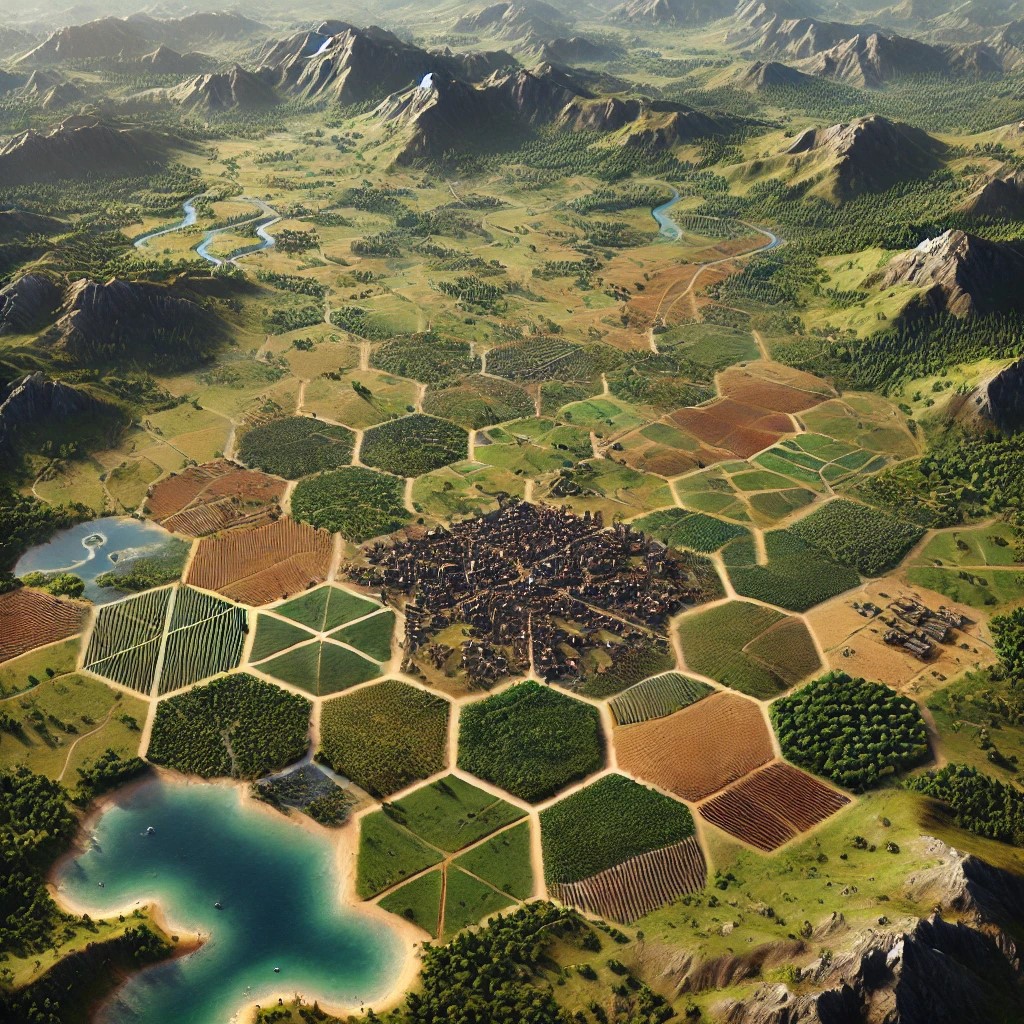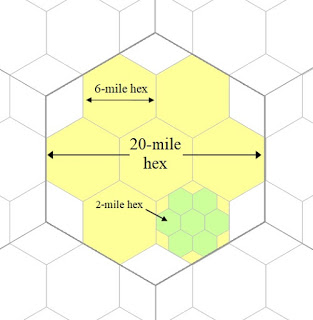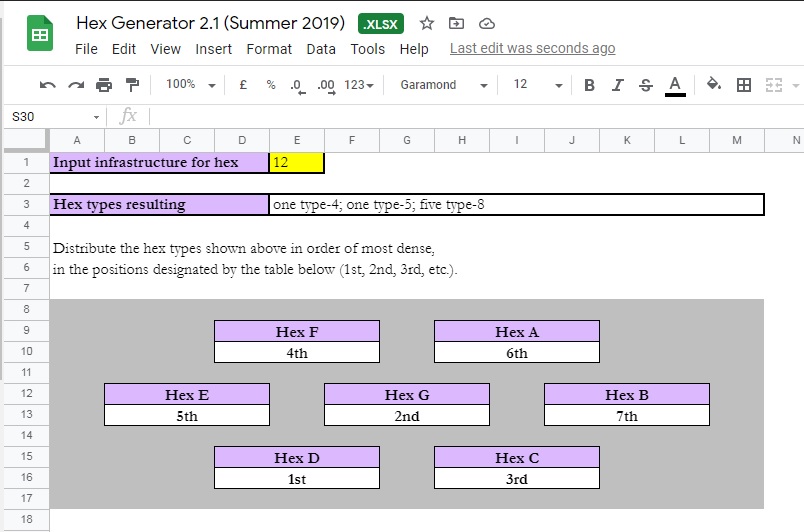Hex Group
Hex groups are a designation for a constituency of 9 hexes that fit conviently inside a larger hex — seven prime hexes and six diamonds each representing ⅓ of a hex. This allows a hex to be subdivided for the purpose of randomly assigning portions of a 20-mile hex's infrastructure number, providing a collection of "hex types" numbering from type-1 to type-8. While the game world is mapped in 20-mile hexes for estimating travel times for player characters and the movement of goods and services, 6-mile hexes as determined through hex groups are used to provide more detailed information for the purpose of running the game setting.
This means of subdividing hexes can be used to expand details of the game world as desired, for 6-mile hexes can similarly be subdivided into 2-mile hexes, which can be reduced progressively into land hexes (1,304 yards), village hexes (434 yards), blocks (145 yards), sub-blocks (48 yards) and lots. This allows us to map virtually anything.
Distributing Groups
Beginning with the infrastructure number for a 20-mile hex, the seven prime hexes, or "group," are randomly assigned an order from 1 to 7. These are then allotted, in order, an amount of infrastructure according to their order. The hexes have a designation starting at the top right and moving in a circle, with the last hex in the centre, as Hex-A, Hex-B, Hex-C and so on. A new random order is assigned to the seven hexes each time infrastructure is distributed, ensuring a unique pattern for every group.
When assigning infrastructure, the original number is divided according to powers of 2: 20, 21, 22, 23 and so on... while assigning empty hexes zero infrastructure. That is,
The total infrastructure must be divided into these seven options, plus zero, when distributing that infrastructure into the subordinate hex group of seven prime hexes... recognising that multiple combinations are possible for most infrastructure totals above 1. For example, 3 infrastructure divided into seven hexes may be, according to the assigned order of the hexes. These combinations might be either 2-1-0-0-0-0-0 or 1-1-1-0-0-0-0. For a total infrastructure of 8-IN, there are nine possible combinations, and for 42-IN, there are twenty-nine possible combinations. The chance of any specific combination occurring, regardless of the total, is always equal. This means that for a total of 42-IN, any of the 29 possible distributions has an equal probability of being selected.
A generator in Excel has been created to automatically perform both tasks simultaneously: assigning the order of the prime hexes and randomly distributing infrastructure across them. The result is expressed as 'types,' ranging from type-8 to type-1. The file includes various flotsam and jetsam that can be ignored.
By inserting the infrastructure number into the yellow box and pressing return, the resulting hex types are generated, showing how many of each type are present. Seven boxes then display how these hexes can be randomly arranged. In the example shown, the single type-4 hex is placed in 'Hex D,' with the corresponding box below marked as '1st.' The single type-5 hex is placed in the '2nd' hex, which is 'Hex G,' the central hex. The remaining hexes are all type-8, which are distributed across the other five hexes.
The resulting hex types are then assigned, in order, to the hexes labeled 1st, 2nd, 3rd and so on. For example, with a total of 12 infrastructure, the type-4 hex is placed in Hex D, the type-5 hex in Hex G, and the remaining five type-8 hexes are distributed across the other hexes.
If an infrastructure result is impossible to create — such as when the powers of 2 cannot sum to 191 — the hex is counted as the next possible lower number, in this case, 190. The highest possible number, 448, accounts for all possible infrastructure values above that, resulting in a group of seven type-1 hexes. These scenarios are handled automatically by the generator. Hex groups of this size and greater are considered fully civilised.
Hex Types
Coastal Areas
If the hex were partly water, so that Hex D had no land or perhaps an inconsequential sliver of land, then the type-4 hex would be placed in the next suitable hex in order, from 2nd to 3rd to 4th and so on. This allows a quick adjustment for odd circumstances that arise in mapping, without needing to create a complicated program to account for such things.
See also,
Mapmaking
Talk:Hex Group


